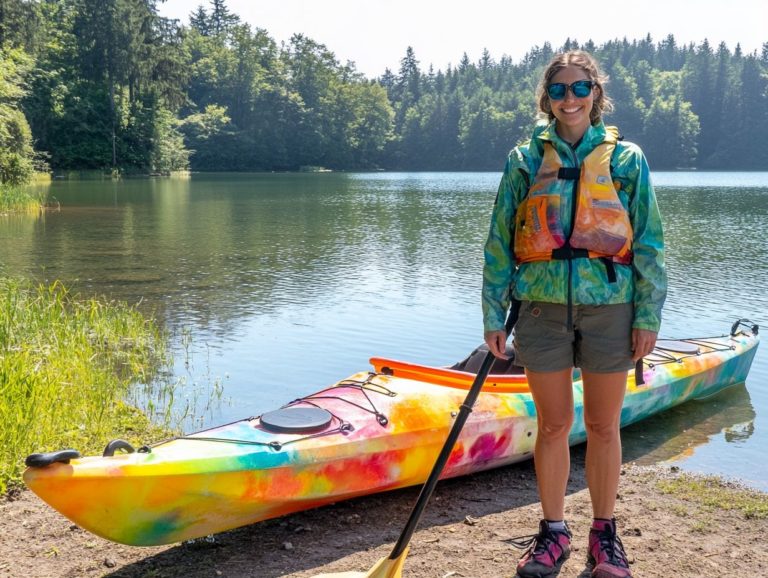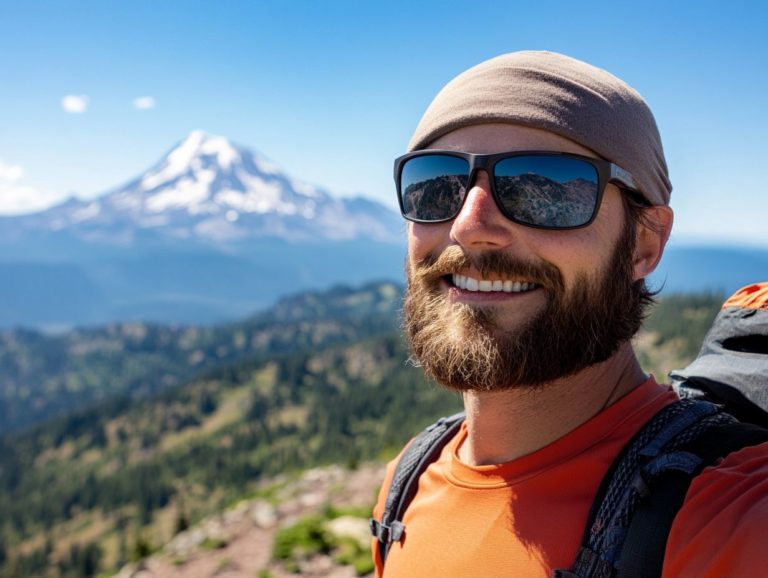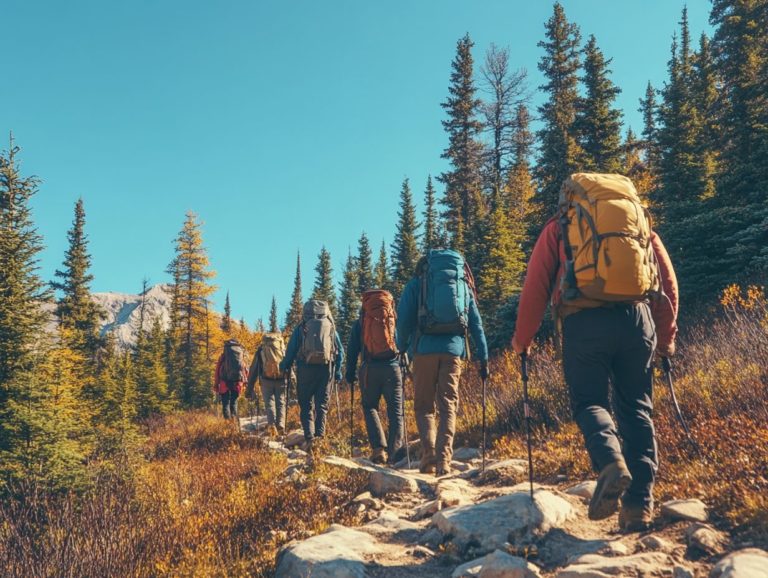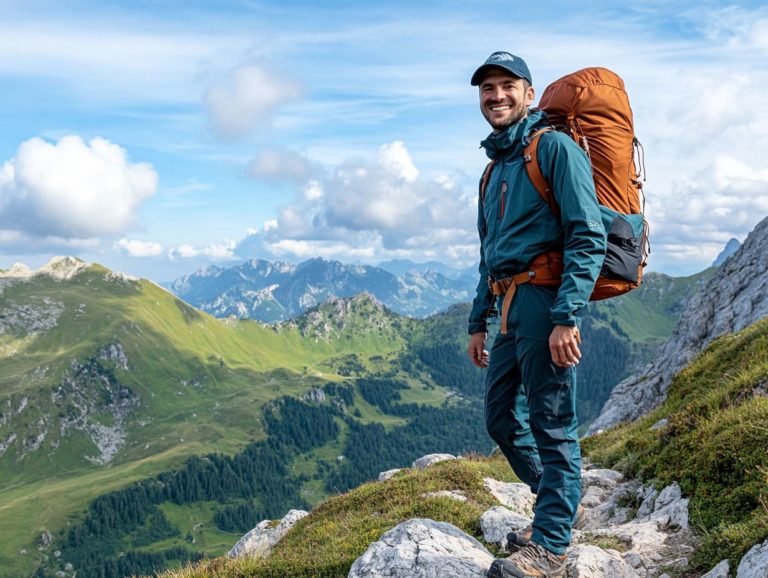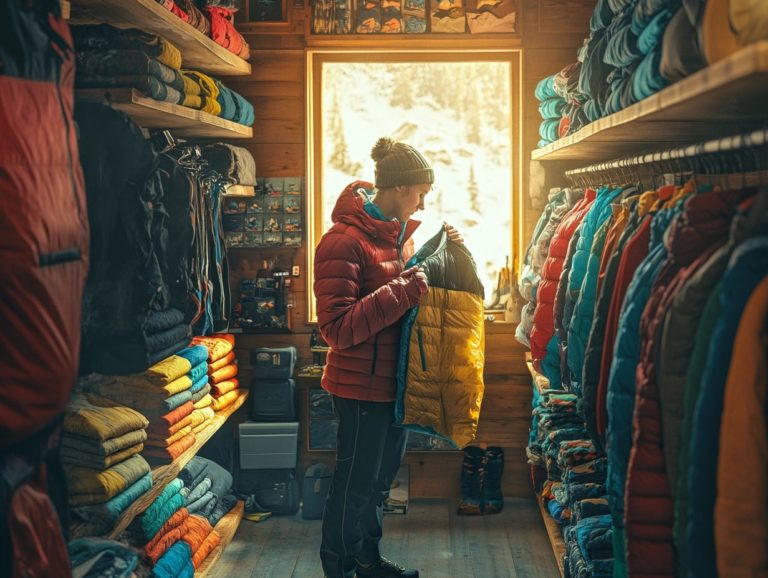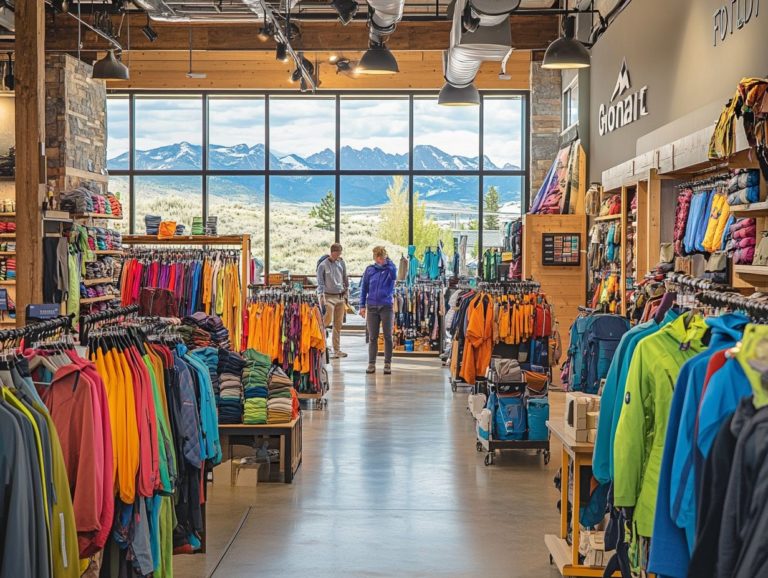Essential Outdoor Clothing for Summer Trips
As summer approaches, the allure of the great outdoors calls to you, inviting you on adventures that await.
Whether you re planning a leisurely hike, an invigorating camping trip, or a relaxing day at the beach, having the right gear is paramount for both comfort and safety.
This article delves into the essential outdoor clothing and accessories that will enable you to navigate the summer heat while remaining protected from the elements. From sun protection to breathable fabrics and emergency supplies, you ll be fully equipped for a successful outdoor experience.
Continue reading to ensure you re entirely prepared for your summer escapades!
Contents
- Key Takeaways:
- 1. Sun Protection
- 2. Breathable Fabrics
- 3. Quick-Drying Materials
- 4. Insect Repellent Clothing
- 5. Waterproof Gear
- 6. Comfortable Hiking Shoes
- 7. Lightweight and Versatile Clothing
- 8. Hats and Sunglasses
- 9. Layers for Changing Temperatures
- 10. First Aid Kit
- 11. Backpack or Daypack
- 12. Navigation Tools
- 13. Emergency Supplies
- 14. Proper Hydration
- 15. Appropriate Clothing for Activities Planned
- Frequently Asked Questions
- What types of clothing are considered essential for summer trips?
- Are there any specific materials that are recommended for outdoor clothing?
- Should I bring extra layers for unpredictable weather?
- What type of clothing should I avoid for summer trips?
- Do I need to bring long-sleeve clothing for summer trips?
- What type of footwear is recommended for summer trips?
Key Takeaways:
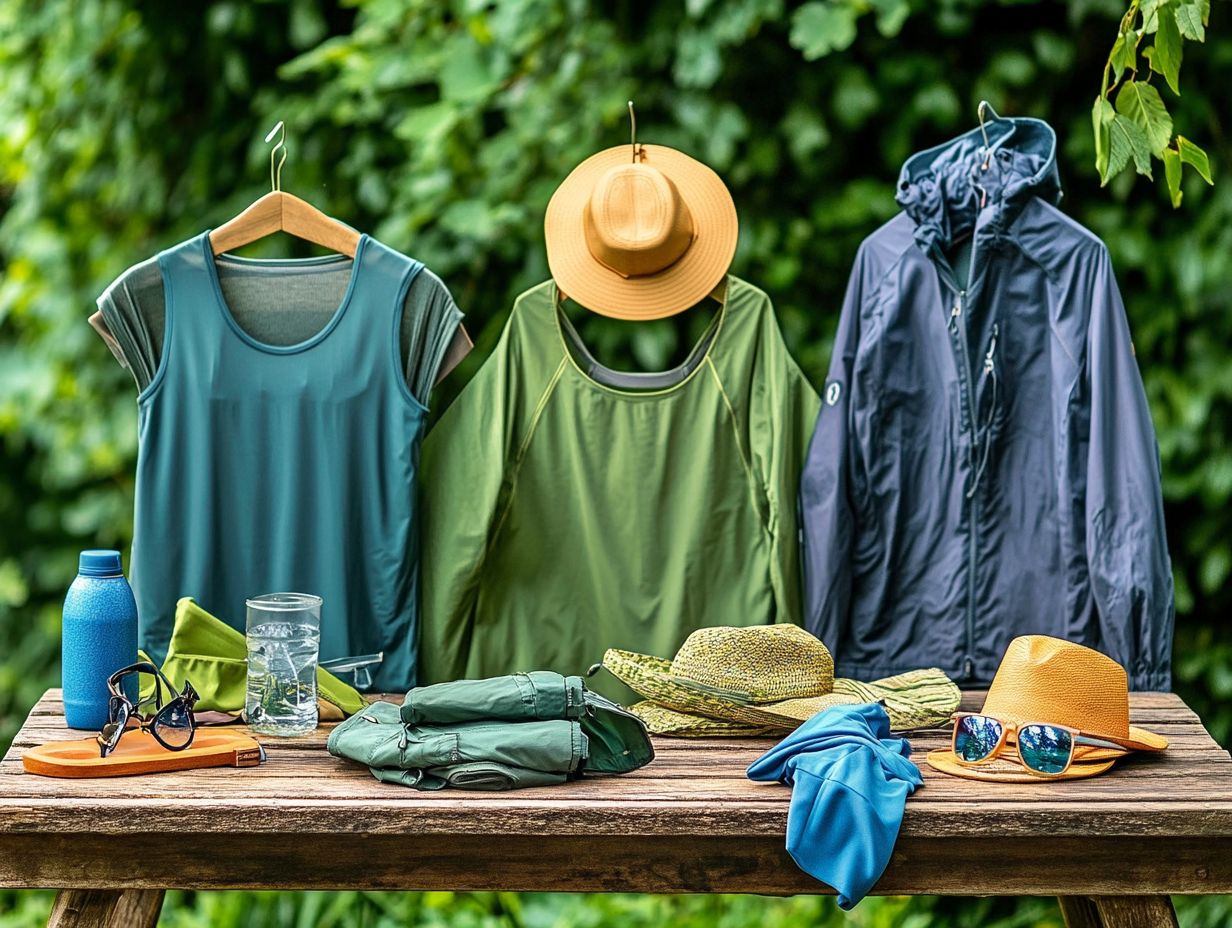
- Sun protection is a must for summer trips – pack sunscreen, hats, and sunglasses to protect against harmful UV rays.
- Choose breathable and quick-drying fabrics to stay cool and comfortable in the heat.
- Be prepared for insect bites by wearing insect-repellent clothing and packing bug spray.
1. Sun Protection
Sun protection is essential when you’re hitting the trails in the summer, especially in places like Colorado, where the sun can be intense.
With the right precautions, you can enjoy your hikes while reducing the risk of sunburn, heat exhaustion, and other sun-related concerns.
To fend off harmful UV rays, it’s crucial to use different ways to protect yourself. Start with a broad-spectrum sunscreen that has at least SPF 30. Remember to reapply it every two hours or right after sweating or swimming.
A wide-brimmed hat can be your best friend, providing shade for your face and neck. Opt for breathable clothing made from UV-protective fabrics, like those offered by brands such as Patagonia and Arc’teryx, to elevate your protection. For more tips on selecting the right gear, check out how to choose outdoor clothing for your next trip. These lightweight materials keep you cool and minimize your exposure to the sun’s rays, making them a smart choice for your summer trekking adventures.
2. Breathable Fabrics
Picking breathable fabrics can make your summer hikes a breeze! These fabrics boost your comfort and performance by allowing sweat to evaporate quickly.
This is especially important when temperatures rise, and long treks require your full focus and energy. Moisture-wicking base layers actively pull moisture away from your skin, creating a dry environment that minimizes chafing.
Lightweight hiking clothes made from materials like polyester or nylon provide both breathability and durability, ensuring you can move freely.
Brands such as Patagonia and Columbia excel at creating performance-driven pieces that shield you from UV rays while maintaining excellent ventilation. Breathable hiking pants made from lightweight spandex blends combine stretch and airflow, making them ideal for various terrains.
3. Quick-Drying Materials
Utilizing quick-drying materials in your summer hiking gear is key. These materials prevent discomfort from sweat and unexpected weather changes, allowing you to remain dry and focused.
Quick-drying materials pull moisture away from your skin, enhancing breathability and comfort during your adventures. Renowned brands like Patagonia and Fjallraven offer hiking pants and shorts that dry rapidly, so you can bounce back quickly from sudden rain showers.
The lightweight, durable fabrics used in these pieces enhance your mobility and reduce chafing, contributing to a positive hiking experience. Choosing gear made from such materials not only boosts your performance on the trail but also lets you enjoy the stunning views instead of discomfort.
What are your must-have items for summer hikes? Share your tips with us!
4. Insect Repellent Clothing
Insect repellent clothing is a savvy choice for your summer hiking adventures, giving you that extra layer of defense against those annoying bugs that can ruin your outdoor fun and threaten your safety.
By choosing long-sleeve shirts and pants made from specially treated fabrics, you can significantly lower your chances of getting bitten by mosquitoes and ticks. This type of clothing doesn t just fend off insects; it also protects your skin from harmful UV rays and minimizes the risk of scratches from overgrown plants.
To boost your protection further, consider applying insect repellent sprays or wipes on any exposed skin. This offers added coverage in tricky spots that clothing might miss.
Dressing appropriately transforms your outdoor experience, allowing you to relish nature while keeping the health risks from insect bites at bay.
5. Waterproof Gear
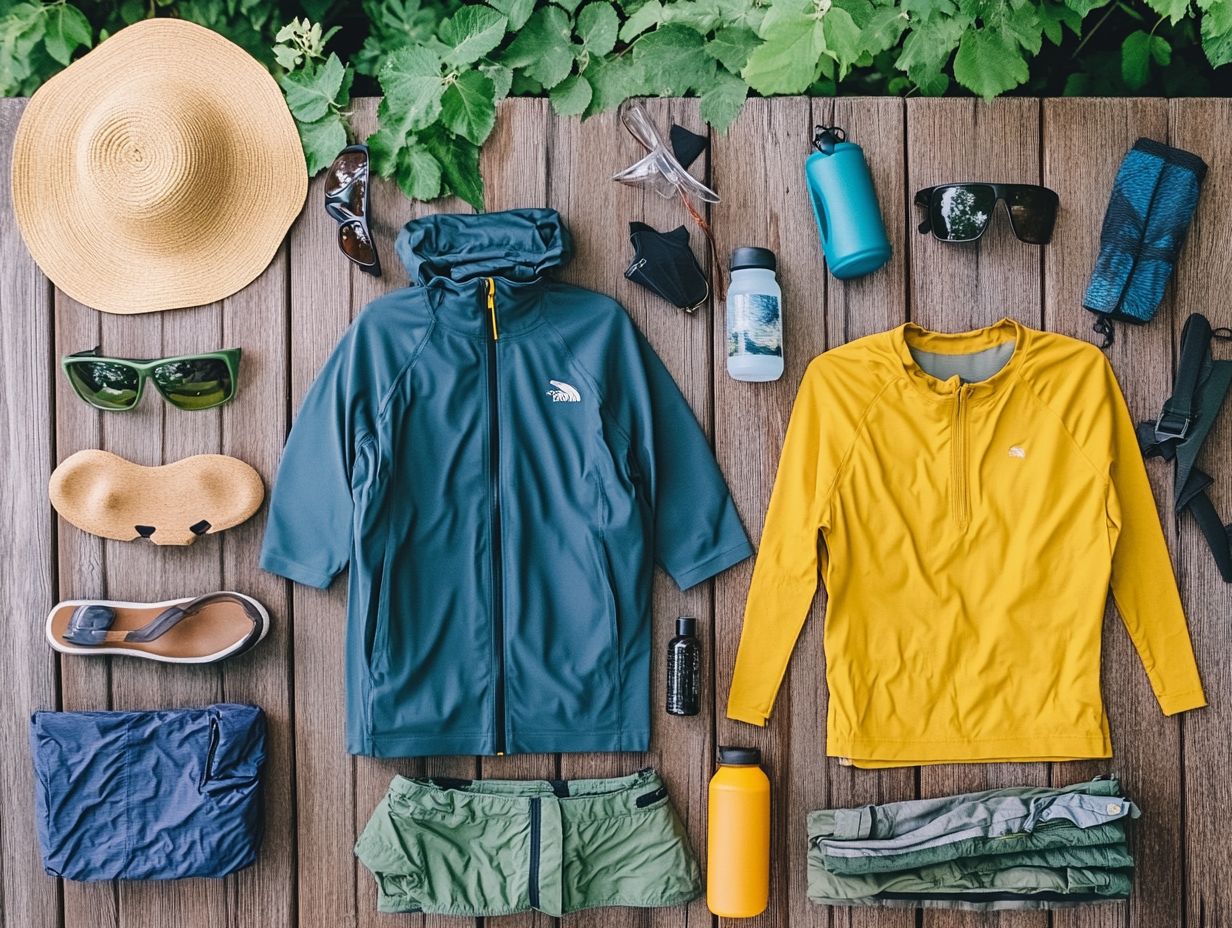
Having waterproof gear is essential for your summer hiking expeditions, especially since unpredictable weather can lead to sudden rain showers. Staying dry and comfortable during your outdoor adventures is paramount.
Opting for the right waterproof jackets and pants, like those from Arcteryx, gives you a reliable barrier against moisture while allowing for breathability. This keeps you dry and comfortable.
When you’re packing for your journey, remember to roll these items instead of folding them. This simple technique saves space and minimizes creases that could compromise their waterproof capabilities.
Emergency shelters are another crucial component of your hiking kit, offering vital protection against inclement weather and a safe refuge when conditions take a turn for the worse. Having the best waterproof gear makes your hiking adventure exciting and safe!
6. Comfortable Hiking Shoes
Selecting comfortable hiking shoes is one of the most critical elements of your summer hiking gear. The right footwear provides the stability, support, and protection you need across varied terrains during your outdoor adventures.
When hunting for that perfect pair, it s essential to look for features like cushioning for comfort on long hikes and grip for improved traction on slippery or uneven surfaces. Waterproof capabilities are also vital; you want to keep your feet dry in unpredictable weather, allowing you to tackle any trail with confidence.
Reputable brands like Patagonia and Eddie Bauer offer excellent options that incorporate these features, elevating your overall hiking experience.
For example, Patagonia s hiking shoes often utilize eco-friendly materials without sacrificing durability, while Eddie Bauer is celebrated for its lightweight designs that enhance mobility. These options are perfect whether you re embarking on a day hike or a multi-day trek.
7. Lightweight and Versatile Clothing
Don’t miss out on lightweight and versatile clothing it’s a must for your summer hikes! This allows for easy layering and adaptability to those unpredictable weather changes you might encounter outdoors.
This strategy enables you to embrace a range of environments, whether you’re navigating cool morning breezes or confronting the relentless midday sun. Sweat-repelling base layers are a must; they pull sweat away from your skin, keeping you comfortable throughout your trek.
Opt for hiking shorts and pants that offer the flexibility to mix and match, perfect for those sudden temperature fluctuations. Pairing lightweight shorts with a long-sleeve top can be a game-changer when dealing with transitional weather.
Brands like Columbia and Patagonia are celebrated for their high-quality, breathable fabrics, ensuring you’re well-equipped for any adventure that comes your way.
8. Hats and Sunglasses
Wearing hats and sunglasses is essential for sun protection during your summer hikes. These accessories shield your eyes and face from harmful UV rays while keeping you comfortable on the trail.
Pick the right hat for great sun protection. Wide-brimmed hats offer fantastic coverage for both your face and neck. In contrast, caps provide much-needed ventilation. Choose sunglasses with UV protection to block harmful rays, enhancing visibility and safeguarding your eye health.
Together, these accessories elevate your hiking experience. They minimize glare, prevent overheating, and allow you to immerse yourself in the beauty of nature without the annoyance of harsh sunlight.
9. Layers for Changing Temperatures
When hiking in the summer, being well-prepared with the right layers for changing temperatures can elevate your outdoor experience. This preparation ensures you remain comfortable, no matter what the weather throws your way.
Choosing the right hiking layers is essential. It enables you to regulate your body temperature through various conditions. Start with a base layer made from moisture-wicking materials that effectively keep sweat away from your skin. Next, add an insulating layer for those cooler moments, trapping essential body heat. For your outer shell, look for breathable and waterproof materials to shield against wind and rain.
Opt for versatile clothing options like lightweight tanks or thermal mid-layers. These options offer fantastic flexibility for your adventures. Layering enhances your comfort and allows for quick adjustments, ensuring your journey on the trails remains enjoyable, regardless of how the weather shifts.
10. First Aid Kit
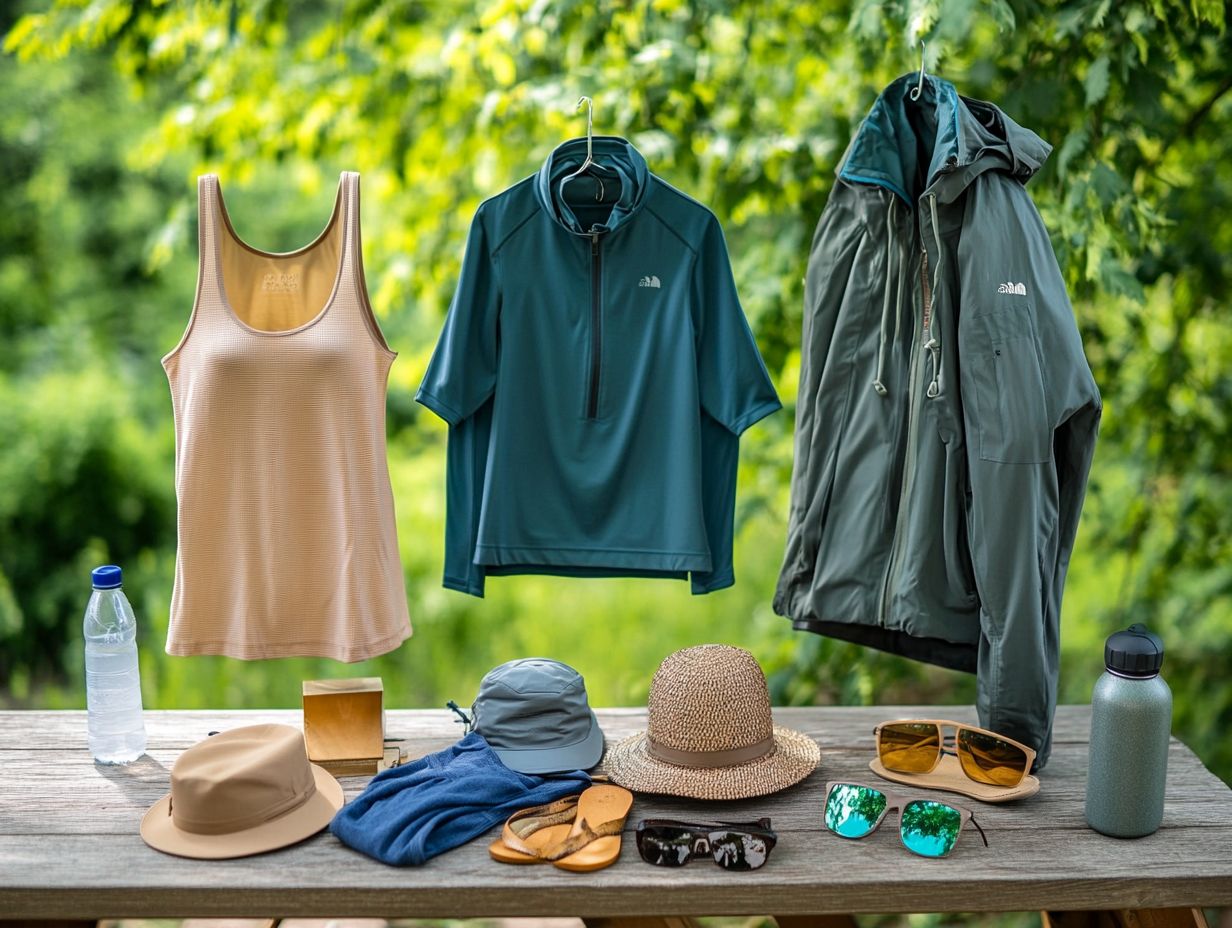
A well-stocked first aid kit is essential for your summer hiking essentials. It ensures you’re ready for any injuries or emergencies during your outdoor adventures.
Having the right supplies can make a difference when faced with unexpected challenges. Whether it’s a minor scrape, an insect sting, or something more serious like a fracture, being prepared is crucial. Customize your kit based on the environment and potential hazards. For example, think about adding bear spray if you re wandering through bear country.
Here s what you should pack for safety:
- Adhesive bandages
- Antiseptic wipes
- Gauze
- Pain relievers
- A compact emergency blanket
Add a multi-tool and a whistle for navigation and emergency signaling. This ensures you’re well-equipped for any scenario that might arise.
11. Backpack or Daypack
Selecting the right backpack or daypack is vital for transporting your hiking gear essentials. This ensures you have everything necessary for a comfortable and enjoyable adventure.
When considering a backpack, evaluate its size. This will determine how much gear you can carry. Comfort is paramount padded straps and a breathable back panel can enhance your experience during long hikes.
Compartments are essential for organization. They allow easy access to your necessities, like water bottles, hiking snacks, and maps.
To pack your hiking essentials effectively, consult an outdoor gear list to ensure nothing is left behind. Roll your clothing to save space and allocate specific sections for items like first aid supplies and cooking gear. This keeps everything in order for a seamless outing.
Using effective navigation tools is essential for ensuring your safety and direction during summer hiking expeditions. This helps you explore new trails without worrying about getting lost.
With a wealth of options at your disposal ranging from traditional maps and reliable compasses to modern GPS devices and versatile smartphone apps you have plenty of ways to stay oriented. Mastering these tools not only enhances your hiking experience but also plays a crucial role in preparing you for unexpected situations during your hiking trips.
For example, while GPS devices offer precise locations, a trusty map can be invaluable in areas with spotty cell service. By honing your navigation skills, you enable yourself as an outdoor enthusiast, ensuring you remain aware of your surroundings and can make informed decisions. This boosts your enjoyment on the trail and significantly enhances your safety.
13. Emergency Supplies
Don t hit the trail without your emergency supplies they re your lifeline during unexpected situations! Packing emergency supplies is a vital part of your hiking preparation, providing you with peace of mind.
- Well-stocked first aid kit: Addresses minor injuries or ailments on the trail.
- Emergency shelter: Protects against sudden weather changes.
- Hydration systems: Devices that help you carry and drink water easily.
- Hiking poles: Provide added support during your hikes.
Together, these supplies protect you against emergencies and elevate your hiking experience, allowing you to immerse yourself in nature without unnecessary worry.
14. Proper Hydration
Maintaining proper hydration is essential during your summer hiking excursions, as it directly influences your energy levels and overall performance.
When you set out on a hike, establishing a water-drinking routine is crucial. Aim to hydrate at regular intervals to avoid dips in your hydration levels.
Consider utilizing hydration systems, like CamelBak packs or Nalgene bottles; these tools make the process convenient and effective. With these systems, you can sip continuously without breaking your stride and ensure you re always prepared with the right hiking gear essentials.
Monitor your hydration status by checking the color of your urine clear or light yellow indicates you re in good shape, while dark yellow could serve as a warning sign.
Being aware of early signs of dehydration, such as fatigue, dizziness, or dry mouth, allows you to take action promptly, ensuring you maintain optimal performance and enjoy every moment on the trail.
15. Appropriate Clothing for Activities Planned
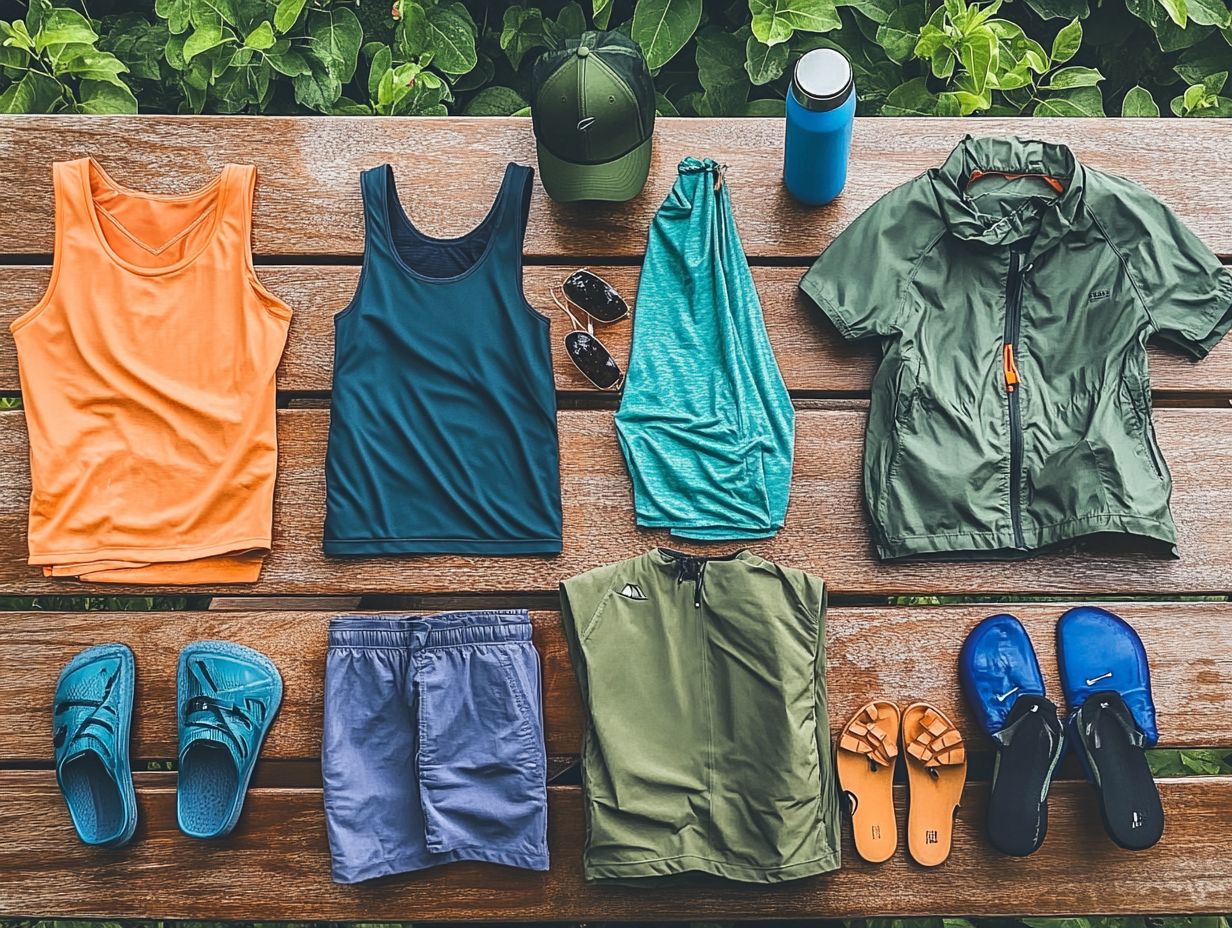
Choosing the right clothing is essential for any summer hiking adventure, as it directly impacts your comfort, mobility, and overall enjoyment in the great outdoors. Investing in quality hiking clothing options can make a significant difference.
When selecting your outfits, it s important to consider the type and intensity of your hike. If you re gearing up for strenuous trails, invest in lightweight, moisture-wicking fabrics and specialized technical gear for enhanced comfort. If you re planning a leisurely stroll along gentler paths, breathable cotton attire will suffice.
Understanding these nuances helps you make informed decisions and equips you to handle any environmental factors, like unpredictable weather changes. Knowing this will help you enjoy a more successful hiking experience!
Frequently Asked Questions
Here are some common questions hikers ask to ensure a safe and enjoyable experience.
What types of clothing are considered essential for summer trips?
For summer hiking trips, choose lightweight and breathable clothes like t-shirts, tank tops, shorts, and skirts! They keep you cool and comfortable.
Are there any specific materials that are recommended for outdoor clothing?
Absolutely! Fabrics like cotton, linen, and moisture-wicking polyester are perfect for staying cool and dry.
Should I bring extra layers for unpredictable weather?
Definitely pack a lightweight jacket or sweatshirt for unpredictable weather! A rain jacket or poncho is also essential in case of rain, especially if you’re venturing into bear country.
What type of clothing should I avoid for summer trips?
Skip heavy clothing like jeans and sweatshirts. They’re uncomfortable and hard to pack!
Do I need to bring long-sleeve clothing for summer trips?
Don t forget a lightweight long-sleeve shirt for sun protection! Look for shirts with UPF (ultraviolet protection factor) for added safety against harmful rays.
What type of footwear is recommended for summer trips?
Choose comfortable walking or lightweight hiking shoes for your adventures! Sandals with good arch support are great too, but avoid flip flops or open-toed shoes for long hikes.
Get ready for your summer adventures and start packing your essentials now!

